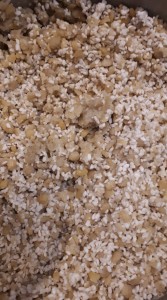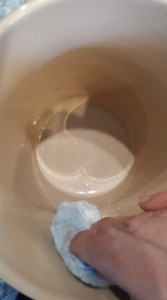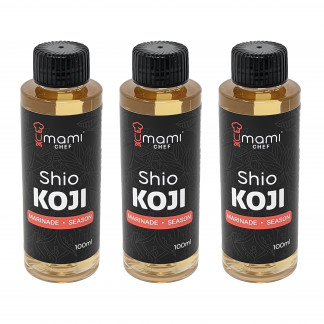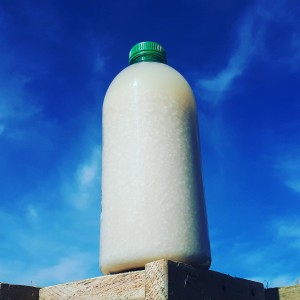
Red Akamiso 赤味噌 Miso is one of the darkest, most flavourful misos. It is typically aged for over a year to produce a rich paste, packed with umami flavours. It’s generally used for marinades or glazes, but it’s strength means a little goes a long way!
The long fermentation time means that a higher salt content (around 13%) is needed. It is also beneficial to make a larger volume than you would for the sweeter misos – smaller volumes may not ferment as well and if you have to wait a year for it to be ready you don’t want to run out of miso once you’ve discovered how delicious it is!
This recipe is for the smallest volume I recommend, although you can multiply it up to create larger amounts, as desired.
When aging misos for a longer period it is also important to put a weight on top of the miso as it matures. This should weigh at least 500g (25% of the weight of the miso being made). This weight will press out any air pockets which form during fermentation, minimising the risk of mold growth.
The taste can be too overpowering for some recipes, so it is often mixed with sweet white miso to produce a blend known as awase miso.
Note: Traditionally soybeans are used to make miso, but as I’m allergic to soy I’ve use fava beans.
Step-by-step Guide: How to Make Akamiso 赤味噌 Red Miso
Equipment
- 2 litre jar
- Saucepan
- Bowl
- A weight for the top of the miso
Ingredients
- 500 g Dried Soy or Fava Beans
- 2 packets Umami Chef Koji
- 220 g Salt
Instructions
- Wash the beans, removing any remaining pieces of shell

- When the water runs clear, cover and leave the beans to soak in cold water for at least 6 hours

- The beans will almost double in volume. Place beans in a saucepan with fresh water and simmer gently until cooked. This will take about 45 minutes for fava beans or 2 hours for soybeans. Alternatively: A darker colour miso can be achieved if the beans are steamed, instead of boiled.

- Drain the beans in a colander, saving the bean cooking water for use later.

- Mash the beans. If you like a smooth miso you can pulse them in a food processor. I prefer a chunky miso (which I can blend to a smooth paste, if a specific recipe requires it, once the miso is ready) Some people also like to put the mixture through a meat grinder, to produce a well mixed paste. All methods will produce a delicious miso!

- Add the salt and mix in.

- Once the beans have cooled to less than 40'C (if you haven't got a thermometer wait until the beans feel the same temperature as your skin - or cooler) stir in the koji.

- Now try to form the mixture into a ball. At this stage it will probably be too dry and fall apart.

- Slowly add the cooled bean water that you saved earlier. Mix well and stop as soon as the mixture can be formed into a ball.Note: If you've forgotten to save the bean water you can used cooled boiled water.

- Get a clean 2 litre jar/crock. Moisten a clean paper towel with bean water and rub a small amount of salt all over the inside - this will help to prevent mold from growing at the edges.

- Press the bean mixture into the jar, one layer at a time. Try to remove as many air bubbles as you can.

- Once all the mixture is in the jar, wipe the edges with a clean paper towel. Lightly sprinkle the surface with salt and then cover with cling film. Find a plate or jar that fits inside your crock and then place weights on top of it. These will continually press down on the miso, removing air pockets as they form.

- Leave the miso in a cool, dry place for a year. Then enjoy!The miso can be matured for longer than a year, it will become darker and deeper in flavour the longer it is left.Note: The miso in the picture has been blended to a smooth paste.
































Hi! I tried this recipe with chick peas and After two days i have some liquid above the mixture. Shall i leave it or remove it?
The liquid is a delicious tamari that you can pour off and use as you would soy sauce. If you are getting liquid after just a couple of days it suggests that your miso is too wet. I would add a weight to the top of the miso (if you haven’t got one already) to push out more liquid over the coming weeks. If you have a lot of liquid I’d remove it as it pools, to try to get the moisture level of the miso down.
Thanks for your reply! I removed the liquid and left the weight i had before. The smell was slightly alcoolic (my miso was in a closed jar). I guess i should leave the jar opened according to your recipe.
Let’s wait a year and see !